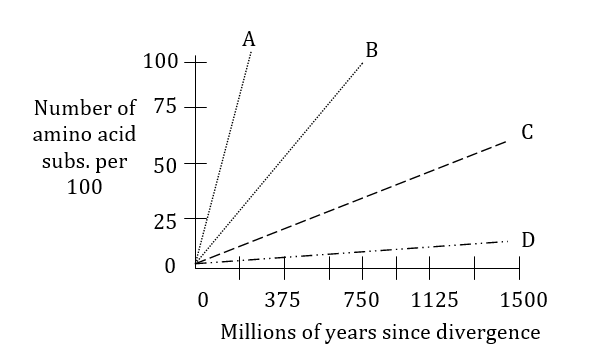The rate of change is not identical for all genes.The following graph shows the rate of change of four hypothetical human proteins (A-D).Use this graph to answer the following questions.

a)Which of the proteins is changing at the fastest rate?
b)Which protein is most conserved?
c)Which evolutionary force (drift,selection,or migration)plays the biggest role in causing the observed difference in the rate of change between proteins A-D?
d)If you do Southern hybridization to determine if the genes encoding each of these human proteins (A-D)also exist in rice,which would give the strongest hybridization signal? Justify your answer.
e)If you were going to use one of the proteins to build a phylogenetic tree of various mammalian species (which diverged during the last 50 million years),which protein sequence would be most useful? Justify your answer.
f)If you were going to use one of the proteins to build a phylogenetic tree of various plant species (which diverged during the past 500 million years),which protein sequence would be most useful? Justify your answer.
g)If you were going to use one of the proteins to build a phylogenetic tree of a mixture of plant and animal species (which diverged 1200 million years ago),which protein sequence would be most useful? Justify your answer.
Definitions:
Gross Domestic Product
The total value of all goods and services produced within a country's borders in a specific time period, serving as a measure of economic performance.
Proportion
The relationship between parts and the whole, often expressed as a ratio or fraction, indicating the relative size or importance of elements within a context.
Services Sector
Part of the economy that provides intangible goods or services to consumers, including sectors like healthcare, education, and financial services.
Intangibility
A characteristic of services indicating they cannot be seen, touched, or physically measured, making their quality and customer satisfaction more subjective.
Q4: In Drosophila melanogaster,Hox genes are:<br>A)clustered into operons.<br>B)clustered
Q19: In an animal bearing the heterozygous inversion
Q22: A particular hybrid species is defined as
Q27: If two populations of birds with frequencies
Q30: A nonautonomous element:<br>A)requires no other elements for
Q34: Recombinant DNA techniques typically require the action
Q35: The _ is the rate that yields
Q100: To maximize profit when a constrained resource
Q145: Return on investment for a given investment
Q148: Profit margin measures how efficiently an investment